A conversation with Mike Aviña, Chris Farling, David Horton, Hector Isaac and Tom Young
A recent magazine ad for the Fujifilm X-T1 said, “The camera you carry is as important as the images you make.” But among street photographers, it is not cool to obsessively discuss “gear.” We take that for granted – cameras are just tools. While that is true, there is no better tonic for “photographers’ block” than a new camera or lens. Some photographers have truly found their vision when they switched to a certain camera. Back in the pre-digital days you had a camera. It was either a Leica, or an SLR. And you kept it forever. Today with so many choices of equipment, a photographer can pretty much find the perfect camera to suit their shooting style and personality. Or is it the other way around? In this post we hope to discover how the equipment a street photographer uses influences what their pictures look like.
GA
Chris, you were shooting with an Olympus E-P1. Your work was solid and gaining some notice. Then you bought an OM-D E-M5 in the spring of 2012 and it seems like your vision really blossomed. I immediately noticed the quality of your work ramp up several notches and that trend continues. Do you feel that you held a vision that the OM-D finally released? Or did the new equipment present possibilities the E-P1 didn’t… i.e., eye-level viewing, fast autofocus, etc.
Chris Farling (CF)
I don’t want to diss the E-P1 overmuch in that the E-P1 itself was a quantum leap over the fully automatic mode-style shooting of the digital point-and-shoots that I had owned over the previous decade. When I committed to ponying up the $$$ to buy the E-P1, I made a parallel commitment to being more serious in my study and practice of photography. It was with the E-P1 that I really dug into controlling aperture and shutter speed and exploring different focal lengths and lenses. I’m actually glad I started with a camera that had some clear limitations (no VF, iffy sensor, slow AF, & poor high-ISO), much the way you need to play the $&@! out of a student horn before moving onto a more powerful but perhaps more complicated or less forgiving instrument in music. Everyone starting out wants to buy some perfect camera that will make them a brilliant photographer overnight, but the paradox is that it’s only through working around limitations that you grow and develop good habits. If you start out with everything handed to you, it can breed in you a certain laziness and you’ll most likely get bored and frustrated.
The E-P1 was also my first experience using fixed prime lenses and that more than anything helped me to “see” as a street photographer would and to be able to pre-visualize frames to some degree. It was really a wonderful camera to experiment with and learn on and I don’t think I will ever sell it.
GA
So you’re saying that a more basic camera can provide a better learning experience?
CF
Exactly. It really did liberate me when I upgraded to the E-M5 along with the Oly 12mm f2 lens because I had much of the basics in place from the E-P1. Most of the gains weren’t surprising in that I knew what I wanted out of this new camera and what advantages it held over the old one. I honestly can’t imagine needing a more powerful camera in the foreseeable future.
GA
That was a pretty wide lens to start with! Just what are those advantages the E-M5 gives you?
CF
The one thing that I want from a camera more than anything else is versatility. And I include the lightweight form factor of the m4/3 system as a key part of that versatility. Not for me the heavy necklace of an SLR… I like to be able to shoot quickly and reflexively and so I don’t even want the camera to be on a strap. The E-M5’s EVF was a real boon to helping me execute better edge-to-edge compositions. I for one really like having all the settings info available in the EVF, though I know many prefer optical ones. The touchscreen, which allows you to tap a focal point or even to release the shutter directly, added even more flexibility. The almost instantaneous AF (as well as the simple zone focusing capability of the 12mm lens’s pull ring) meant that I could depend on my own sense of timing and reflexes and not worry that the camera wouldn’t respond when I was ready. The E-M5 helped me to learn more about on- and off-camera flash. Perhaps the most useful thing, surprisingly enough, was simply the extra customizable dial and button, allowing me to have immediate tactile access to virtually any setting I would want to change quickly in anticipation of the next shot. Also, it bears mentioning that the rich Olympus JPG quality from both cameras has influenced my color sensibility.
As much as I like the E-M5 and feel that it has helped me develop and execute my vision, I’ve since adopted the APS-C sensor Ricoh GR as my principal camera, reserving the E-M5 for special situations where I want the different lenses or the weatherproofing. In many ways, the Ricoh is a step backwards in quality and features, yet it is so perfectly portable and well-designed in its flexibility (a real photographer’s camera) that those advantages trump all other considerations. Plus there’s that awesome TAv mode that let’s you specify both aperture AND shutter speed… I find the Ricoh is the perfect camera for my style of quick close-in shooting with a fixed 28mm-equiv. and I suffer little when adapting it to other types of shooting.
GA
So with the E-M5 you became accustomed to the convenience of customizable dials? That would make the GR a logical move because, since the line’s inception, it has been praised for its flexible interface. As DP Review said, “We’ve often referred to the Ricoh interface as arguably the best enthusiast-focused interface on a compact camera.”
David, you followed a similar path as Chris, moving from an E-P2 up to the OM-D E-M5. Among this group of photographers, you used the focal length closest to what is considered a “normal” lens: 20mm (40mm equivalent). There is less margin for framing errors than with a 28mm or even 35mm. As a graphic designer, tell us how the precise eye-level framing of the OM-D has influenced your photography, especially with the 20mm lens.
David Horton (DH)
When I first started dabbling in SP, I was using a Canon G9 which has a 35mm default lens. I liked that length a lot. When I moved to the E-P2, I opted for the Panasonic 20mm (40mm equiv.) because it was considerably faster than the 17mm Oly lens* (34mm equiv.) and it received considerably better ratings and reviews.
GA
*You mean the Olympus 17mm f2.8 Pancake, correct?
DH
Yes. Oly’s first 17mm prime did not have very good performance especially in the corners. Although I used the Pany 20mm almost exclusively for over a year (and was very pleased with the IQ of the lens), I often found the focal length limiting. I wished it was a little wider.
The primary reason I moved to the EM-5 was speed. Although I adapted to the slow autofocus of the E-P2, I was missing more and more shots. Although the add-on EVF on the E-P2 was acceptable, it was a bit cumbersome. I shoot exclusively through a viewfinder. So the ergonomic design of the built-in viewfinder on the EM5 was also very appealing. What I didn’t know until I received the camera is that, to benefit from the increased speed of the EM-5, you also had to have one of the newer Oly lenses. At the time I bought I camera, the fast Oly lenses only existed in 12mm and 45mm lenses. The 12mm (24mm equiv.) was too wide for me. I waited for at least three months for the rumored 17mm 1.8 lens to come out. (It was my dream lens.) I preordered it and got it as soon as it released. I’ve used it exclusively since the day I got it. The combination of the EM-5 and that lens is extremely fast.
The other thing I like about the EM-5 as opposed to something like the Fuji X100 (which I also considered) is the ability to change lenses. Although I rarely do, it’s nice to have that option. I always carry the 45mm 1.8 Oly lens (90m equiv.) with me too, just in case.
GA
It is nice to have the ability to change lenses, particularly when on a trip, even if you don’t do it often.
Mike, you have used quite a variety of equipment, from Leica M3 to Sony RX1 and many things in between including compact P&S’s and the Ricoh GR. I know that you are a dedicated student of photography with a deep curiosity about what is possible. Does this explain your variety of equipment? You seem to always come back to shooting b&w and I have the impression that, ideally, film is your medium of choice and because of that much of your digital work looks like film.
Mike Aviña (MA)
I’d like to challenge the conventional wisdom of sticking to one camera and one lens. There is a time and a place for sticking to a narrow set of gear. When you get completely accustomed to one focal length and one camera the gear does become more intuitive, you can set up shots and frame them before you pull the camera up to your face because you know where to stand at what distance to include given elements. That said, smaller cameras have certain advantages: deep depth of field, very fast autofocus, and tilt-screens. There are world-class photographers that have discovered and exploited these advantages. I just purchased a published book shot entirely by phone–the images are superlative. I’ve made 12” by 16” prints from an LX7–they look great.
To answer your first question–yes, I prefer film. The dynamic range of film and the separation of subjects one can achieve with shallow depth of field on a fast lens is a necessary creative tool. I have never used complicated post-processing to add blur to digital images; this is a method that ends up looking artificial. A wide, fast lens on either a full-frame sensor or over film is therefore a must-have. Shallow depth of field however is only one tool and not one I use all or even most of the time.
GA
Arguably, you can come pretty close having a digital image file look like it was shot with film in post processing. But the methodology of shooting film is a whole ‘nother animal.
MA
Film versus digital ia probably better left for another discussion! I also have an abiding love for small, pocketable, point-and-shoot cameras. As others have mentioned above, small cameras are easier to haul all day. In addition, shooting like a tourist, with innocuous little shots framed through the LCD rather than a viewfinder, is often more effective than pulling a big rig up to your face and clacking away. Even with a small rangefinder, people react more when you pull a camera up to your face than they do to an apparent tourist snapping casually with the LCD. I tend to frame faces off center; when using a wide angle lens this means people are often not sure they are in the shot because it isn’t clear you are shooting at them. The shooter and the subject have a complicit agreement to the fiction–the photographer is shooting something else; the subject ignores the shooter as long as it isn’t too intrusive. This helps one work close in crowded spaces. Having a bundle of different tools allows flexibility and simultaneous exploration of different creative options.
GA
You make a very good point Mike. Why shouldn’t we use whatever tool best suits the situation? Some of our peers carry dslr’s with a zoom lens mounted that will cover most scenes. Maybe one of them will comment to the pros and cons of a zoom.
Interesting path you have followed Chris… from LCD framing, to eye-level framing, back to LCD framing. I found myself “borrowing” the small Samsung EX2F I bought for my wife and became addicted to the tilt screen. I find that I am very comfortable shooting from waist level and I really prefer the perspective of that PoV, rather than “looking down” at everything from my 6’2″ eye level.
How hard was it to adjust back to the loose framing of the GR’s LCD screen versus the precise eye-level framing of the E-M5? The concrete canyons of NY offer some shade to better see the screen, but how do you frame in bright sunlight when you travel? How often do you use the optical viewfinder?
CF
I do use the optical viewfinder on the GR sometimes (in a way, it’s less obtrusive and noticeable than holding the camera out from your body) but I have a tougher time seeing all four edges of the frame in the viewfinder than I do with the screen. As wide as I generally shoot, I have to kind of scroll with my eye in each direction and that’s too limiting and slow for me. I also don’t like the tunnel vision that develops where you can’t receive new information about the way the scene is changing and what’s happening on the margins with your peripheral vision. With the OVF, you also don’t see the central AF point if you’re using that to lock AF and then recompose. It may seem like a minor point, but I’m also very left-eye dominant so I have to block my whole face with the camera when using the VF, even if it was a corner-mounted one.
GA
An interesting observation I have made is how most of us frame on an LCD using both eyes, but frame through an eye level viewfinder with one eye closed. Truth be told, for street photography, framing using any device is probably best done with both eyes open, but a hard habit to get into with an eye level viewfinder. I find an optical viewfinder more conducive to shooting with both eyes open and it gives you the advantage of seeing what is going on outside of, and about to enter or leave the frame.
CF
That is an interesting point about shooting with both eyes open. That may be what I like about using the LCD of the GR. Viewing the LCD in sunlight hasn’t bothered me too much with either the E-M5 or the GRD since the screens can be made pretty bright. Most of the time your own body acts as shade and, even when it doesn’t, you can still easily see which shapes and areas of light and dark correspond to what you’re seeing with the naked eye. I think it’s actually kind of cool having a slight degree of abstraction (less detail) when considering the composition, the same way a photo thumbnail is often easier to use for judging the effectiveness of a composition in editing than the enlarged version.
It’s also interesting that you say you prefer shooting from a more mid-body angle than always looking down at everything. Being 6’2’’, I have the same issue and, while using the 12mm lens almost exclusively for a year, I became cognizant of the great care one must take in controlling the perspective distortion with a wide-angle lens. Even having backed off to the 28-mm equiv. of the Ricoh, I still think that the default orientation with such a lens should be relatively straight on and not tilted excessively.
DH
My biggest gripe with the EM-5 is you have to rely too heavily on the digital interface. I wish there were manual knobs to adjust the ISO, aperture, and shutter speed. Since I don’t use the LCD, I have it turned off. To adjust any of these settings, I either have to hold the camera to my eye and turn the knobs or turn the LCD on and adjust them. Neither option is ideal or fast enough. This is what I find so appealing about the X100 or a Leica. I also can’t wait until they design better battery life for these digital cameras. As Chris can tell you (from spending a day shooting with me), I opt to carry a number of batteries with me than worry about preserving battery life in the camera. I turn it on and leave it on. When I need to react quickly, I don’t want to have to wonder if the screen’s going to be black when I bring it to my eye.
GA
That’s what evolution has brought to cameras, David. With a basic film camera, like an M3 or Nikon F you have two settings: shutter speed and aperture… and, of course, focus (and film choice). Cramming so many features into a small digital camera leads to compromises.
Mike made a good point about not limiting ourselves to a single tool. Sometimes we tend to set unnecessary limitations for ourselves. Although we may at any given time favor a particular set of gear, I think most of us here have more than a single camera. We always have the option to change cameras if a project or different direction comes to us Having your equipment be intuitive is the most compelling reason for limiting equipment choices. When I saw you this last summer Mike, you were using the Sony RX1. The IQ is the obvious reason why this camera has a strong following. Is it your perfect camera? If not, what would be? The others can answer this as well.
MA
The M3 is, for me, more or less the perfect camera–I am just reluctant to keep spending the money on film. The chemicals also concern me. For an everyday digital shooter the Ricoh GR may be my favorite. The RX1 has laggy autofocus which hinders the advantage of the high IQ and beautiful rendering that the Zeiss lens offers.
GA
David, you mention that you use an eye level viewfinder exclusively–is that because you want precise framing? How come you didn’t gravitate toward a DSLR? There are plenty of choices in size and features to fit any budget and many SP’ers use them. Was it because you already had m4/3 glass?
DH
I certainly find my framing more precise and that’s certainly one of the primary reasons I shoot this way. Perhaps, the more significant reason is that I feel “more at one” with the camera and the subject(s). I shoot a lot of portraiture and even when I’m not shooting conventional portraiture, it’s very important that I’m in sync and “connected” with my subjects. Facial expressions and details are very important to me; these are impossible for me to see if I’m relying on a screen. Shooting with a screen is fine for shapes and loose compositions but it’s not very precise—certainly not precise enough for me.
The reason I’m not interested in a DSLR is size. I don’t like to draw attention to the camera and a DSLR certainly does that. I’m also not interested in lugging one of those suckers around the city on a regular basis. I will occasionally lust after the IQ of DSLR sensors but the trade off is not worth it to me. I’ve spent the day shooting with friends that use DSLRs and after a day walking 10 miles around a city, they are not happy campers. The smaller and lighter the camera, the more likely you are to bring it with you.
GA
Tom, you use a full-frame DSLR. While the 5D is not huge by DSLR standards, it is huge in terms of what everyone else here uses. Obviously it’s hard to be inconspicuous. How do you work around that? I would assume that the quality and precise framing a DSLR offers is important to the type of pictures you want to create.
Tom Young (TY)
There’s a number of different reasons I shoot with an SLR. For one thing, I don’t only shoot street. I also do weddings, events, the odd corporate photography gig. I even shoot landscapes! Egad! So while the 5D is a big rig, for many of the situations I find myself using my camera its size doesn’t really matter, and its image quality is definitely a plus.
But for my street work it can also be an asset. I shoot in a town that is really dark in the winter. During the darkest months, the sun doesn’t get up until after I get to my day job, and is already down again before I leave. And I dabble a bit with flash, but available light is generally my preference. I love the night, really, the strong contrast, dramatic brightness surrounded by black. The full-frame SLR lets me work in that environment and still get nice clean shots.
GA
I would imagine the high ISO image quality to be a must in the arctic. But how do you deal with subjects when they see you pointing that big honker at them?
TY
Hey wait a minute, Edmonton may be north, but it’s not the artic!!! I find that the right attitude is the key to remaining inconspicuous. People may be more likely to notice my camera because it’s big, but that doesn’t necessarily mean they will care what I’m doing with it. When I first started shooting street, it seemed that people noticed me more than they do now, probably because I spent a lot of time sweating bullets about what I was doing. I really didn’t want to be noticed. And I assumed people would think it was odd. I hadn’t squared in my own head what my motive was. I knew what types of images I wanted to produce, but I didn’t have a clear sense of purpose. Best way to stand out in a crowd? Look embarrassed or uncomfortable while wielding a big camera, or worse, a small camera.
GA
That is excellent advice Tom.
TY
With experience, that fear has dropped way off for me. Now, when I pull out my camera, I’m pretty confident about what I’m doing. And while the odd person may raise an eyebrow, most people don’t seem to think anything is unusual about what I’m up to. I can only assume that means that I look like I belong in the landscape now. Hidden in plain sight, in a sense, despite the fact that I don’t really try to hide my activities any more. So I think the knock against SLRs being too big for street work is a little overblown.
Mind you, it probably helps that I’m not a terribly in-your-face shooter. If I was shooting Gilden-style, the big camera might tip people off before I could get close enough…
GA
A lot of photographers feel that anything longer than 50mm equiv, or even 35mm, is “against the rules” for street photography. How do any of you feel about that David? You sometimes use the Olympus 45mm f1.8 (90mm equivalent).
DH
I think many “rules” of street photography are pretty ridiculous. I try not to pay a lot of attention to the rules. I believe all that really matters is the success of the shot. Yes, there is an energy and authenticity that comes from a wider lens that is very appropriate for the street—there’s good reason most of us use them most of the time. But limiting yourself to that perspective exclusively is a bit short-sighted (sorry, couldn’t help myself). A lot of magic can happen when compressing images. It can be a very painterly way of seeing, especially with a large aperture. You paint with colors and shapes rather than objects or subjects. It’s a slower, more studied way of seeing. Saul Leiter is a perfect example of this. It all depends on the mood you’re trying to achieve, the story you’re trying to tell.
GA
You shoot with a Fuji x100, Hector. Am I correct in understanding this is your first camera? You don’t have previous experience with film? The x100 is a popular camera with street photographers. You mentioned that it took awhile for you to feel comfortable with it. I have heard other reports that there was a steep learning curve with this camera. How does the hybrid viewfinder help or limit your shooting style? Is a fixed focal length limiting… do you ever wish it was a little wider, or longer?
Hector Issac (HI)
You are correct, Greg, I had no previous experience with film or any other medium and the Fujifilm x100 was my first camera. Recently, I was asked by a friend… Why that camera? I didn’t have an answer. I still don’t, but I’m glad I got it.
For most of those coming with a broader photographic background, the x100 was a struggle, for me it was a love/hate situation that still exists. After my first try, I almost sold it, then it was left on the shelf for one or two months. It took me about another three to four months to get comfortable enough to get what I wanted. The main issue back then (cough cough) was the autofocus, well … it sucked, so I decided to learn to work manually and zone focus, rather than sell the camera and buy another… Best decision I ever made.
I’m a bit obsessive when I’m interesting in learning something, so my learning curve was rather steep given the amount of time I spent to learn my camera and about photography in general. The hybrid viewfinder helped me learn the camera’s frame lines, even if the lag was a problem.
GA
Thanks Hector. I have heard from others that the x100 has a steep learning curve. But those who master it love it to the point of becoming evangelists. Interesting choice as a first camera but it seems that diving in on the deep end and making the commitment has served you well!
There are many ways a photographer’s equipment choices shape the pictures they produce. Even though the street photography genre has been slow to embrace anything other than straight, unmanipulated images, today we have so many more choices in equipment and post processing than we did on the pre-digital era. While it should be easy to create a signature look, remarkably much of today’s street photography is fairly homogenous. We invite you to comment with your thoughts on the relationship between photographers, their cameras and the images they produce.
“I am surprised that my prints sell. They’re not pretty. They’re not those kind of pictures that people can easily put on their wall. They’re not that window on to a nice landscape or something.”
“I don’t have to have any storytelling responsibility to what I’m photographing. I have a responsibility to describe it well.”
of being brash or pushy mistake his intentness of purpose. Exploring
photographic problems was a purely selfish pursuit and all consuming for him.
“We know too much about how pictures look and should look. How do you get around making those pictures again and again?”
“Frame in terms of what you want to have in the picture, not about making a nice picture, that anybody can do.”
“When I’m photographing I see life.”
NOTE ON THE QUOTES
FOOTNOTES
1) The majority of photographs in this exhibition were printed by Winogrand or under his supervision by Thomas Consilvio or Paul McDonough. The rest were made after his death and unless otherwise noted, were printed in 2012-2013 in Tuscon, Arizona by Teresa Engle Schirmer. All are gelatin silver prints.In his last years, Winogrand put off developing his film and editing his contact sheets in favor of shooting. At his death he left behind approximately 2,500 rolls of exposed but undeveloped film and 4,100 more that he had processed but not reviewed, representing most of his production during the last six years of his life. Winogrand had allowed others to edit his work and print his photographs, however, and in preparing for its posthumous 1988 exhibition Garry Winogrand, the Museum of Modern Art, New York, develped. proofed and edited the work he left behind. That show included a small group of prints made by Consilvio from late images selected by John Szarkowski, director of MoMA’s department of photography, and by Winogrand’s friends and fellow photographers Tod Papageorge and Thomas Roma.
Many earlier Winogrand photographs also remained unprinted at his death. For the present exhibition, therefore, guest curator Leo Rubenfien undertook a two-year review of the bulk of 22,000-odd contact sheets in Winogrand’s archive at the Center for Creative Photography at the University of Arizona, Tuscon. Over ninety posthumous prints made from Rubinfien’s selections and drawn from the full span of Winogrand’s career are on view here. The labels for these prints indicate whether Winogrand marked a given frame on its contact sheet, suggesting that he found it to be of interest.
2) On May 4, 1970, four Kent State University students were killed and nine injured when members of the Ohio National Guard opened fire during a demonstration protesting the Vietnam War. John Filo’s iconic photograph of the tragedy won a Pulitzer Prize. (Wikipedia).
3) Dan Weiner (1919-1959) studied painting at the Art Students League and Pratt Institute, eventually accepting a job as a commercial photographer. He joined the New York Photo League and developed an affinity for the work of Dorothea Lange, Walker Evans, and Russell Lee. Following World War II, he pursued work as a photojournalist, refining his belief that the photographer has a moral responsibility to illuminate social ills and to comment on significant events in history. Weiner’s life was tragically ended by a plane crash while he was on assignment in 1959. (www.robertmann.com).
4) Personal communication.
REFERENCES
Evans, Walker, essay by Linclon Kirstein. American Photographs. 75th anniversary ed. New York: The Museum of Modern Art. 2012.Kotz, Liz. “Damaged.” 21-28: Coleman, A.D. “Diane Arbus, Lee Friedlander, and Garry Winogrand at Century’s End.” 31-37. The Social Scene. Ed. Stephanie Emerson. Los Angeles. The Museum of Contemporary Art. 2000.
Lifson, Ben. “Garry Winogrand’s American Comedy.” Aperture 86: 32-39. 1982.
Rubinfein, Leo. “Garry Winogrand’s Republic.” 13-61. Garry Winogrand. Ed. Leo Rubinfein. San Francisco: San Francisco Museum of Modern Art. New Haven and London: Yale University Press. 2013.
Szarkowski, John. The Photographer’s Eye. New York: The Museum of Modern Art, 1966.
Winogrand, Garry, introduction by Tod Papageorge. Public Relations. 2nd ed. New York: The Museum of Modern Art. 1977.
Greg Allikas, May 2013
Eileen and Garry Winogrand, Woodman, Wisconsin 1973
posted by Greg Allikas, May 31, 2013
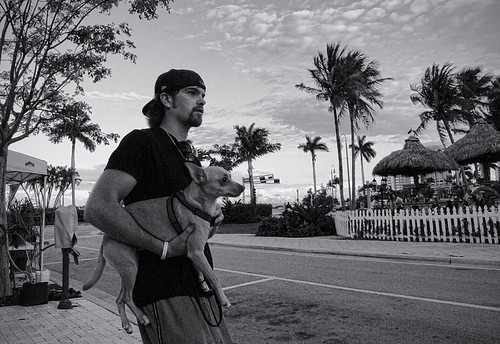
kon’-tekst, noun
The interrelated conditions in which something exists or occurs.
Since the renewed interest in street photography there is a never ending discussion as to what exactly, street photography is. While a consensus is rarely reached, there are some givens. First and foremost, street photography is candid photography. By all standards, a photographer’s intervention in the scene being photographed is unacceptable. Street photography and documentary photography (and photojournalism) are bound together and can overlap. A picture can be both a documentary and street photograph. The fine line that distinguishes them is in perceived storytelling. Simply put, street photography asks questions, documentary photography provides answers (hopefully). Street photography has no responsibility to be compassionate or address social issues (although it may). It is the selfish expression of the photographer’s view of the world captured for his or her own pleasure. While there is a certain “look” to street photography, it is hard to define and continually evolving. While telephoto lenses are widely used in photojournalism, they are not in street photography.
A comment about the photo above brought to mind another characteristic of street photography: context. A photographer, who judging from his own photos is new to street photography, suggested that I do a vertical crop to include just the young man and dog. The soft puffy clouds, swaying palm trees and empty street contrast oddly with the focused gaze of man and dog, at what, we don’t know. It is the context that makes this more than just a photo of a man and a dog. The tranquil setting itself enforces the oddness of the man, the way he is holding the dog, and their fixed gazes. Imagine how different this photo would have looked with cars and people in the background.
A street photo can be as much about context as about subject. Often it is the context that is the reason for a street photo. The subject becomes secondary. It is this attention to context that separates street photography from documentary. For street photographers, managing context is often more challenging than subject. The more complex the scene the more difficult getting the elements into place becomes. While some street photography may look like random snapshots, choreographing a scene into a single still frame in a split second is challenging. It is also exhilarating when it succeeds.
When I first began taking photographs it was pretty simple. I would see somebody or something interesting on the street and I would take a picture, The camera was loaded with Tri-X and had either a 24, 28 or 35mm lens on it. I didn’t know I was doing street photography and they weren’t even calling it that then. I had no intention of creating artistic images and any concept of style was founded on content. I don’t think that Winogrand, Freidlander, Arbus, Levitt, Erwitt or any of the pioneers of the genre ever thought about creating artistic photographs. In this new blossoming of street photography slick style is much admired.
In the first year of the SPNP project certain modern SP clichés became evident. We have the “people juxtaposed against advertising posters”, and “pocket of light”, many iterations of feet photography including “feet with colorful shoes against yellow road stripes”, pigeons are a recurring theme and reflections in windows are always a good way to fulfill any brief.
I stopped doing the SPNC briefs because I don’t want to be under pressure to have to take a certain picture. I want to shoot what I want to shoot. This past year a quote by Winogrand is sitting on my shoulder like a conscience; “How do you keep from taking the same pictures over and over again?” He went on to add, “When I go out to shoot I don’t have pictures in my head. I frame in terms of what I want to have in the picture.” That sounds deceptively simple. But he didn’t say “Look for dramatic light” or “Use diagonals and bold shapes.” Perhaps it is the absence of a consciously applied style that has made Winogrand’s work so enduring and monumental.
I have spent the past couple of years experimenting (with color!) and trying to see where I fit in between the content driven style of the past and the artsy style of the present. It has proven confusing. A few months ago I came up with the idea that maybe what Winogrand was getting at when he asked how we get around taking the same pictures all the time was at its point, an absence of style. In other words, people, their behavior and the world we live in is so infinitely variable that all we really need to do is decide what we want in the photographic frame and that when we apply certain ”style” we are in effect, making pictures that look like others.

Last year this photograph by OakT really captivated me and I continue to refer back to it. While seemingly simple in its presentation it resonates with humanity and carries the weight of daily existence we all face. It is more than just a photograph. It’s visual anthropology. I came across a quote by Joel Meyerowitz this week that is another arc in closing this whole circle of thought; “Over the years I have seen that photography is too often about the pictures only. To me it’s always been about ideas and the ideas that pictures generate.”
the Norton Museum of Art in West Palm Beach has opened its exhibition of the five nominees for the inaugural Rudin Prize for Emerging Photographers. The award calls on five internationally acclaimed photographers to act as a nominating panel, each selecting one emerging artist who is at the leading edge of contemporary photo-based art and has yet to have a solo show in a museum. The winner of the prize, to be selected by the museum’s Photography Steering Committee and announced on December 4, will receive a cash prize of $20,000 and a solo exhibit at the Norton.
If you go to the exhibit expecting to see fine examples of photography, save for Eunice Adorno’s intimate photo essay, you will be disappointed. If you go expecting to be surprised at what is regarded as cutting edge photography, you will be quite pleased.
Adorno was nominated by Magnum photographer, Susan Meiselas. Her series of color photographs, titled “Las Mujeres Flores”, reveals the strict social traditions that define Mennonite women in northern Mexico. The work shows the craft of a photographer in control of her medium who has the facility to create a strong narrative with images. The group of photographs shows an understanding and respect for her subject.
Gabriela (Nin) Solis, also from Mexico, and Mauro D’Agati, from Palermo, Italy presented traditional photography as well. Solis’ work was black and white analog silver gelatin prints and D’Agato’s, color pigment prints. Solis was nominated by the esteemed Mexican photographer, Graciela Iturbide. Her prints were quiet pieces, many of them small, some cropped to square. They were studies of the effects of a superhighway construction project in Mexico. If the work possessed the visual strength of one of the Westons or the enigma of her nominator, we may have come away remembering it. But it did not. Her compositions have become lost in the hundreds of other images seen that day. D’Agati’s work represented a look at the underworld of Naples through the eyes of “Carmine”, but without being told, you would not know. A large collage of mugshots could have as easily been traffic violators as mafia players. The photographs lacked the intensity one might expect of the subject and as images themselves, looked like what you can find at online photo sharing websites. Both artists’ work depended on a written explanation to understand it.
I won’t even pretend to understand or explain Analia Saban’s mixed media work. The monochrome pieces involved scraping the gelatin off of silver gelatin prints and trailing it across an adjacent canvas panel.
I am certainly open-minded and I doubt anyone would call me a prude. Had I seen this selection of Sven Venø’s work at a gallery in Manhattan or San Francisco I would have reached the same conclusion and simply forgotten about it. One wall of his exhibit contained three large, realistic color photographs on aluminum, and to the right were three pedestals with running videos, each corresponding to one of the three still photographs. We were told one of the videos was eight hours long. Venø is the subject of his work, portraying different characters in much the same way as Cindy Sherman. In fact, her name was mentioned during the curator’s talk. At approximately 3×4 feet, it would hard to not notice Venø’s penis sticking out from his denim shorts. While I was not offended by the photograph, I didn’t see much point in it either. It was just a color photograph of a guy on a rope ladder with his dick hanging out. The English artist explains that his work explores the traditional roles of masculinity and that he does so by playing the part of the fool. I think most people know that a penis defines a male. This looks like exhibitionism masquerading as art.
The day after the preview and opening of the exhibit, I received an email from a fellow photographer I had seen there the night before. “Did you see the porn part of the exhibition at the Norton? After we heard the talk I walked around again…and there was a video on of a guy masturbating with an ejaculation and all…” I told her I had not seen that.
While the large still exhibitionist photograph did not offend me, the notion of the video certainly does. How does a parent explain to their child, or teenager, that a “real” man jerking off is a perverted act that should immediately be reported to the police, but a video in a museum of a man jerking off is “art”? Art that might be rewarded with a $20,000 cash prize!
A fear of perverts and pedophiles whipped up by the news media pervades the community. I have been told on numerous occasions by city security officers that I “cannot photograph children playing in Centennial Fountain.” Other photographers here tell of similar incidents in other public places.
Any discussion of obscenity involves community standards. What is appropriate for one city may not be for another. One has to wonder whether the new William & Sarah Ross Soter Curator of Photography, Tim Wride, believes the exhibit will be seen as a major coup for the museum, or whether he goes in to work every day dreading email from outraged museum goers. Perhaps the nasty bit of business is buried deeply enough in the eight-hour video that few if any will actually see it. We only hope the decision to be controversial does not cost the museum in the long run. With more great photographic art now than ever, it is surprising that the museum would exhibit something of such questionable taste and low moral standard.
posted by Greg Allikas, October 15, 2012
By Greg Allikas
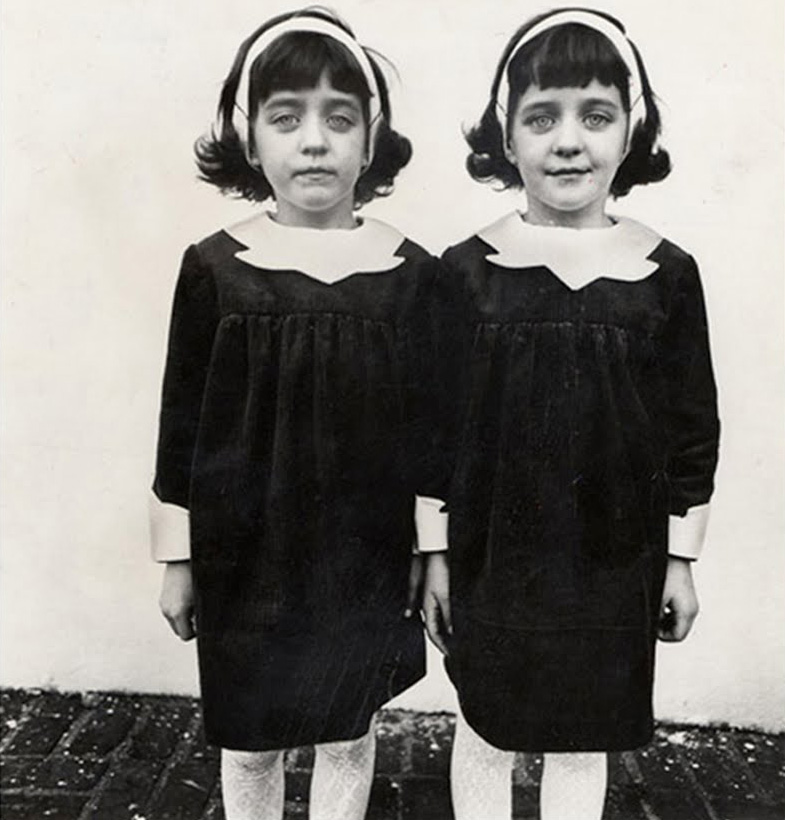
Diane Arbus, Identical twins, Roselle, NJ 1966 (archives.evergreen.edu)
July 7 marked the sixth anniversary of John Szarkowski’s death and I thought it fitting to look at his contribution to photography, specifically how this single exhibition shaped what we now know as street photography.
Forty-six years ago the “New Documents” exhibition closed at the Museum of Modern Art in New York. The show featured ninety-four prints by three relatively unknown photographers; Diane Arbus, Lee Friedlander and Garry Winogrand. The exhibit was a landmark event for modern photography. The show, curated by John Szarkowski, the director of photography at the museum, inextricably linked the three photographers together and made their careers. The new student of photography should understand that at that time, except for the work of a handful of photographers, most museums did not have photography collections or departments. The photographs of Ansel Adams, Edward Steichen, Alfred Stieglitz and Edward Weston represent the type of work that did exist, if at all, in a museum. Few if any photography galleries existed. For the most part, photography was photography, not art. Because it was a mechanical process and perceived to be “easy” by most, easier than painting anyway, it was not taken seriously. One could argue that Szarkowski single-handedly changed that whole notion with this one exhibit. It took some time to take root, but “New Documents” set the movement in motion.
Szarkowksi succeeded Steichen at MOMA in 1962. He was only 37 and had a large pair of shoes to fill. Stiechen had curated the monumental “Family of Man” exhibition in 1955. It contained 500 images by 273 photographers both famous and unknown and was built on a theme of the human experience…birth, death, love, joy, sorrow. The show was a huge success and toured the world. The book is still popular. While “Family of Man” was a landmark exhibition it did not break any new ground in the photographic vocabulary and relied on existing documentary traditions. It was more about the subjects of the photographs than the photographs themselves. Photojournalism was socially responsible and served to report, inform and affect change. Arbus, Friedlander and Winogrand had no such goals. They selfishly photographed for themselves. Szarkowski wrote in his introduction to “New Documents”1, “In the past decade this new generation of photographers has redirected the technique and aesthetic of documentary photography to more personal ends. Their aim has been not to reform life but to know it, not to persuade but to understand. The world, in spite of its terrors, is approached as the ultimate source of wonder and fascination, no less precious for being irrational and incoherent.” His egalitarian view that anyone, anywhere, anytime could create a great photograph worthy of comparison to the masters shaped the future of photography and has become commonplace within the photo sharing websites of today’s digital age, where stars are born and die every day.
1967 was the year of the “summer of love” yet it was a turbulent year in America. The country was deeply involved in Vietnam and civil disobedience plagued cities across the country. Riots in Detroit required the National Guard to restore order and left dozens of people dead. The Equal Rights Amendment would not be passed for another five years. Cameras used film and photographers had darkrooms. With so many social and political events ripe for documentary photography, 1967 seemed an inauspicious year to present an exhibit of photographers so preoccupied with their own personal agendas.
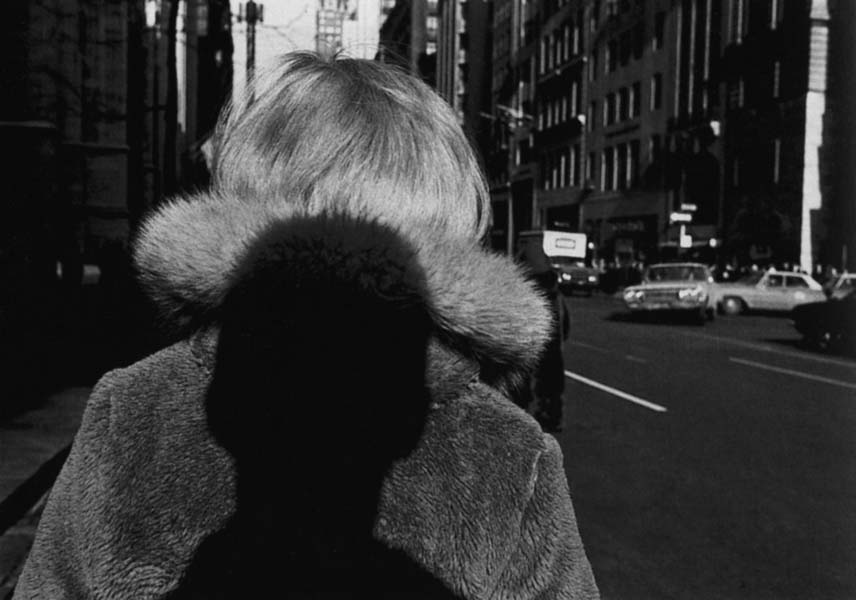
Lee Friedlander, New York City 1965 (sfmoma.org)
“New Documents” received a cool reception. Jacob Deschin wrote, “”The observations of the photographers are noted as oddities in personality, situation, incident, movement, and the vagaries of chance,” in his New York Times review2. Nine years later Szarkowski would take an even bolder risk with “William Eggleston’s Guide,” which was met with even more skepticism. Today Eggleston is considered to have set the stage for fine art color photography3 at a time when the materials and medium were far more limited than they are today.
What did Arbus, Freidland and Winogrand have in common other than working in black and white? They all used small 35mm cameras, although Arbus eventually moved up to a 2-¼ square Rolleiflex. The photographs of the two men are closer to each other than the work of Arbus is to either of them, Both men realized the importance of photographic context, but Friedlander was inclined to often deal only with the elements of place while Winogrand was self-admittedly interested in people. While Arbus may have taken photos on the street, she was primarily a portraitist and is lumped into the street photography genre solely because of her inclusion in “New Documents.” Her methodology had little to do with the “catch as catch can” approach of Friedlander and Winogrand and depended on cultivating a trust with her subjects, sometimes over a period of time. Perhaps Szarkowski sums it up best in this excerpt from a museum press release4 for the exhibit, “What unites these three photographers is not style or sensibility; each has a distinct and personal sense of the use of photography and the meanings of the world. What is held in common is the belief that the world is worth looking at, and the courage to look at it without theorizing.”

Garry Winogrand, World’s Fair 1964 (masters-of-photography.com)
In 1967 street photography was not a new invention. One could argue that the early work of Atget, Brassai and Kertesz was essentially “street photography”, although Brassai posed his subjects on occasion. And of course there were Henri Cartier-Bresson, Helen Levitt and Lisette Model (whom Arbus studied under) and Robert Frank’s opus from ten years earlier, The Americans,. Winogrand himself was profoundly influenced by Walker Evans, American Photographs. These works, however, relied more heavily on documentary traditions than the frivolity of Friedlander’s storefront reflections or Winogrand’s public relations. In an interview with John Pilson5 published in 2011 Tod Papageorge describes Sunday night get-togethers (including Joel Meyrowitz) at Garry Winogrand’s house as being focused on discovering just what photography was, and wasn’t. Papageorge goes on to say that much of the conversation was about photographic “problems” and strategies to solve them. How much information could be crammed on to a 24x36mm piece of film and still be coherent when viewed as a print? Must the horizon be level? What happens when you use flash? What happens when you use flash at a slow shutter speed? What happens to something when you photograph it? In an essay for the catalog for the exhibit, “The Social Scene”6, A.D. Coleman writes about “New Documents”, “Increasingly asymmetrical, unbalanced, fragmented, even messy, especially in contrast to preceding photography, this work demanded of both photographer and viewer an openness to radically unconventional formal structures.” With its snapshot view of the world, the work carried an authenticity that was not evident in the work of say, Eugene Smith, or the FSA photographers where it could be said that the photographs were not entirely candid, or entirely honest. Many of the visual mannerisms we now take for granted had not been seen before “New Documents” nor had such seemingly banal subject matter. The ways in which these three photographers used their cameras opened up a new visual vocabulary for generations of photographers. But it was John Szarkowski’s willingness to take risks that expanded the borders of modern photography. It may be no idle claim that he was once referred to as “the man who taught America how to look at photographs.”
Here is a list of the photographs that appeared in the exhibit.
Notes
1. Museum of Modern Art archives; press release, February 28, 1967;www.moma.org
2. The New York Times; July 9, 2007; www.nytimes.com
3. While color photography was commonplace by the 1960’s it was nothing compared to today’s technologies. Kodachrome was very sharp film but involved a proprietary process that only few color labs could afford. Hence, film had to be sent off for processing. At ASA 25 it was very slow and full sun would give an exposure of about f5.6 @ 250. C-41 color negative films were also slow but gave one additional f-stop at ASA 64. The various Ektachrome films were not nearly as fine grained as Kodachrome and the dyes in processed slides were not as stable as Kodachrome either. If not stored properly you could expect to find faded colors and fungus on old Ektachromes. We referred to High Speed Ektachrome of the 70’s (ASA 160) as having “grain the size of golfballs.”The biggest obstacle however for color to be used for so called “fine art” photography was the available processes for making prints. Conventional “C prints” of the time made from color negatives (or internegatives from slides) had dyes that were extremely fugitive. If displayed prints received significant light, natural or artificial, fading could be noticed in as little as a few years. Who wants a piece of art that needs to be kept in a closet? Also, color was never truly faithful even if printed by a professional lab. Dye transfer prints were the best color print available at the time and were relatively stable, but they were costly and only available from top tier professional photo labs. Cibachrome prints came later. While permanent, color fidelity was hit or miss and the process used toxic chemicals hazardous to home users. Consequently, most serious photographers who sought a place in “fine art” photography worked in black and white. Properly processed and stored silver gelatin prints should have an unlimited life.
4. Museum of Modern Art archives; press release, February 28, 1967;www.moma.org
5. John Pilson; “Taking Pictures”, Tod Papageorge in Conversation with John Pilson”; Aperture #204, Fall 2011; New York
6. A.D. Coleman; “The Social Scene”, The Ralph M. Parsons Foundation Photography Collection at the Museum of Contemporary Art, Los Angeles; Los Angeles;2000
FOTOfusion recently wrapped up at the Palm Beach Photographic Centre. This annual event brings world class photographers to town to lecture and teach workshops. I had a chance to attend a few lectures including one by Ralph Gibson. The hour was spent surveying his work from beginning to present accompanied by comments on thought and process. I have always admired Gibson’s work and consider him one of the photographic masters of my generation. Unlike today’s digital photomontage masters or even Jerry Uelsmann with his multiple negative composites, Gibson manages to embody a surreal quality to his images merely by what he includes, or excludes from the frame. The brilliance of his mastery of this art became more evident to me after spending an hour with him. Little did I know that he started out as a street photographer! His street work predating the 1970 book, The Somnambulist, is inspired and his path to future work is evident.
Another thing I learned about Ralph Gibson is that like Henri Cartier-Bresson, he uses a Leica M series with a 50mm lens. Is there a magic to this focal length that these two, and other masters have discovered? As long as I have been a photographer the so called “normal” lens has been the one least used in many a photographer’s lens arsenal…unless it were a macro. Some pros don’t even own one. Most street photographers favor something wider: a 35mm or 28mm (or DX equivalent). The logic being that the photographer is part of the action rather than a distant observer. For today’s street shooters a 50mm lens carries somewhat of a stigma as producing images that are not really “street.” Worse, on a DX crop-sensor DSLR, the 50mm becomes a 75mm lens which is a short telephoto, totally unacceptable for street photography. Or does it?
The beauty of a 50mm lens is that it produces the same perspective as the human eye. Mount a fifty on a DSLR and look through the camera with both eyes open and the objects seen through both eyes are about the same size regardless of whether the camera is full frame or crop sensor. The spatial relationship of objects in the frame is the same regardless of the size of the camera’s sensor and approximates that of our natural vision. In order to qualify as a telephoto, a lens would compress those spatial relationships just like a wide angle lens expands them. Even on a DX camera body a 50mm is a “normal” lens, it’s just that the camera sensor is not big enough to accommodate the entire image the lens produces. That certainly does not make it a telephoto.
There is something to be said for discipline in our artistic endeavors. By not having to concern ourselves with process we can concentrate on the task at hand: the challenge our tools present us in expressing our vision. I remember a trip I took to Brazil some fifteen years ago. I did not want to risk taking my work cameras so I took an old camera body and several lenses ranging from 28mm to 200mm. I spent the whole trip changing lenses rather than trying to make photos through any one of them. Too many choices! Artists have always found ways of imposing limitations to challenge their artistic vision. Painters may select a certain canvas size or a limited color palette, or work with knives instead of brushes. Plastic cameras like the Diana are still popular and create a certain look through their limited capabilities. The photographic masters mentioned above and others I suspect, like Elliot Erwitt and Robert Frank, have discovered a certain magic in a 50mm normal lens and learned to respect the limitations of a singular way of seeing.
TOP: New York Minute, NYC 2011 – taken with 50mm f1.8
ABOVE: Ralph Gibson – West Palm Beach 2011
KC – DISCIPLINE
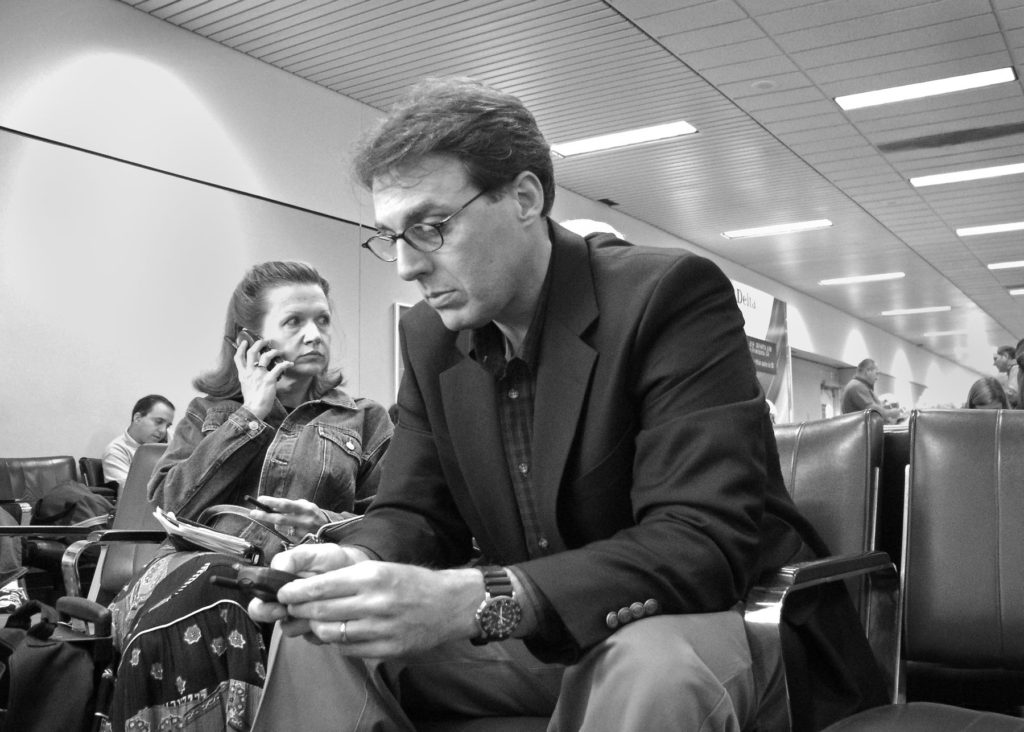
welcome to the age of robots. You may not have noticed, but they’re here. Everywhere. I am not referring to the ones that build automobiles in factories or the ones that Roomba® in your home. I am referring to the ones that technology has so gracefully and gradually slipped into our lives that we haven’t even noticed. Like a 1950’s sci-fi movie, had they come from another galaxy they would have already conquered the earth. But who would have thought they would have no arms or legs and fit inside a pocket?
I have a stupid phone. Although it probably does things that I don’t use it for, it fits in my pocket and makes telephone calls very easily. If my phone were smarter I would probably teach it to reply to “am I loved?” and “am I needed?” Judging from the compulsive behavior exhibited by people at malls and airports, that seems to be the primary function of these devices. Don’t start lobbing rotten tomatoes at me. I too can be compulsive when I have uploaded an especially good photo to Flickrpoosted to social mediaeed to. But when I leave the house the Internet and email stay behind and I treasure the separation from connectivity. That is especially true if I am on a pleasure trip. I am really not important or needed enough to have to be available at all times. Man, am I happy about that~! There are times when I feel like grabbing the phone out of the hand of some boorish idiot in front of me in the checkout line and smashing it to the floor. Sorry, this wasn’t meant to be a device bashing post. Let’s get back to the robots.
When I saw the commercial for the iPhone 4s it struck me that this was more than a phone or even a pocket-sized computer. With the advanced capabilities of voice recognition it has become a personal assistant. How cool is that? And she fits in a pocket and goes with you everywhere. If I were twenty or thirty years younger I would be so into mobile technology. Just the ability to carry my whole commercial photography portfolio as a multimedia presentation on a tablet the size of a magazine would close the deal for me. And it surfs the web and does email too…and more!
There is certainly the seed for a science fiction movie here. Some Blofield-like maniac bent on ruling civilization could devise a way to take over smart phones the world over and control people’s minds…or their bank accounts! I have reached a point in life where I accept almost anything as being possible but don’t believe it unless I see it. So I advise you, it is not too early to start thinking about robot insurance.
Old Glory Insurance
posted by Greg Allikas, November 9, 2011
As I have been posting these older photographs, several things have become evident. I have noticed, particularly with the bus series, that these people do not exist downtown any more. For one thing, this particular bus stop is gone. It was the main stop back then. Either the middle class has made the upwardly mobile move and are now disguised as young professionals, or the whole demographic of West Palm Beach city proper has changed. Government offices and toney restaurants have replaced the Woolworths and Kresge five-and-dimes. The last of the downtown department stores, Burdines, has not only long ago left downtown, but the shopping landscape altogether. The ubiquitous Starbucks is frequented by yuppies (do they even call them that anymore?) reading the daily news on their iPads. Has West Palm Beach finally grown up, or has the world just changed? Or both? There is certainly no longer any need for pensioners to go downtown. There are plenty of dollar stores taking over strip malls in the outlying areas.
While we may think of ourselves as street photographers and street photography not as journalism, we are social documentarians. Anthropologists. Takers of a visual census of our time. We may not know that in the present, but it becomes evident in our photography as it acquires the rich patina of time. One of the characteristics that identifies street photography (for me) is that we do not have the responsibility of journalism. We are not required to be compassionate, or responsible or to fulfill any mandate to tell a story. Yet in the end, our work may end up being all of these things.
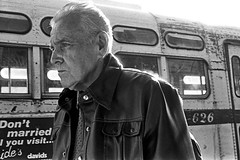
TOP: Bus #4, West Palm Beach 1980
ABOVE: Don’t Get Married, West Palm Beach 1980


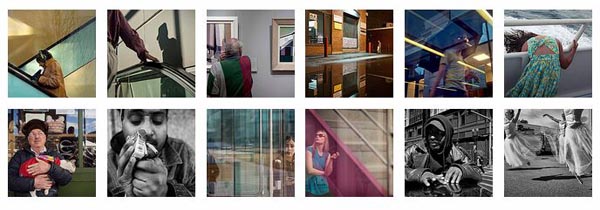
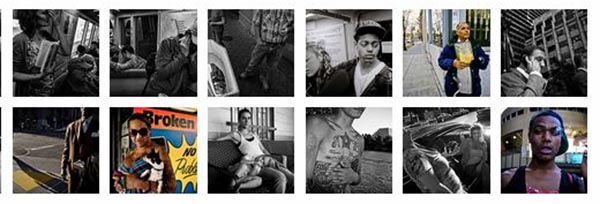
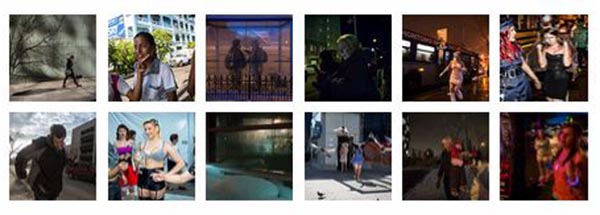


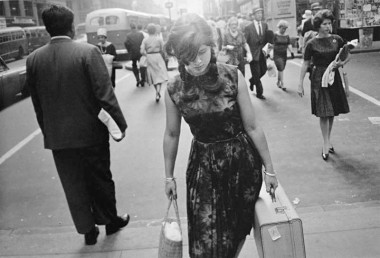
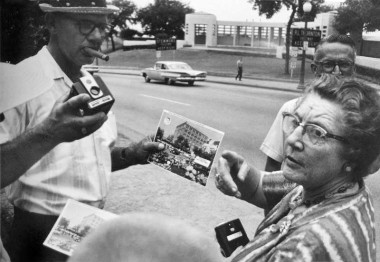


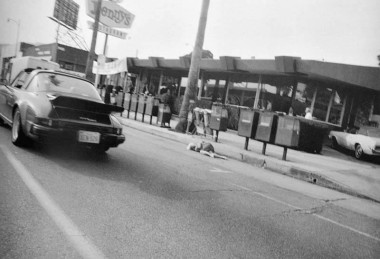
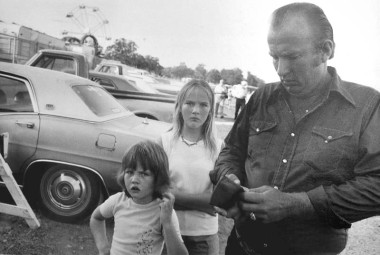
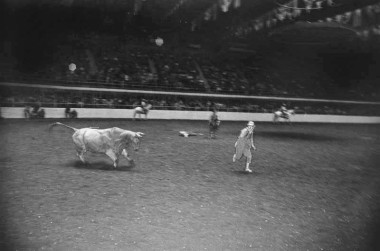
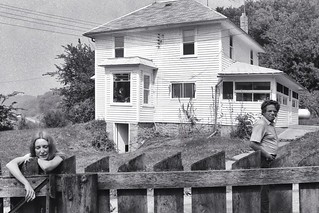

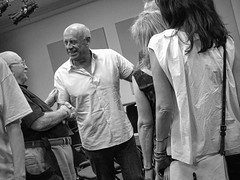
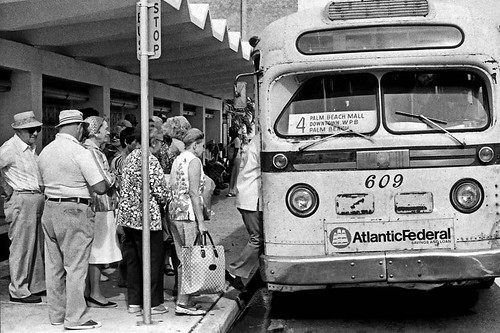
Robots